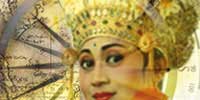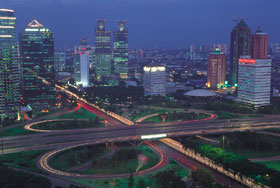|
Jakarta, the capital of the nation, has a fascinating history. Lots of different aspects have colored the city history and the life of people today. Since the fifth century, ships from China and Champa (Vietnam), and from all islands in the archipelago docked at the mouth of the Ciliwung river. Indian and Portuguese traders also visited this small town. Javanese sailors, carrying spices from Molucca, also docked there. Nearly all people from the East and West left their trails to blend special flavor of Jakarta.
Concised description of old historical buildings and monuments refers to the site where the city of Jakarta itself begins. All historical evidence points to the area of the Kota, the old city on the banks of Ciliwung river. A bit south of the place currently known as Pasar Ikan or Fish Market was planted the first tiny seed that developed into a huge city of more than 10 million inhabitants. When did Jakarta start its journey throughout history? Nobody knows exactly!
If we stand on top of Menara Syahbandar (the Lookout Tower) across the bridge over the Kali Besar, we enjoy a view of oldest area of Jakarta. To the north we can see the present old harbor with its colorful prahu (saliboats) and the Java Sea.
Some 300 meters to the south, you can find a renovated old drawbridge. In the time of the Dutch East-India Company colonialism, the bridge was called Hoender pasarbrug or Chicken Market Bridge. At that time, between 17th and early 18 centuries, ships could sail further up to the river Ciliwung. Towards the south of this drawbridge, the once busy harbor town of Sunda Kelapa stretched along both sides of the river between the 12th century and 15th century.
Sunda Kalapa was the main port of the Hindu Kingdom of Sunda . The capital of the Pakuan Pajajaran kingdom was located two day journey upriver, now known as Bogor. This port was often visited by ships from Palembang, Tanjungpura, Malacca, Maccasar and Madura, and even by merchants from India and South China. Sunda Kelapa exported, among other items, pepper, rice and gold.
In 1513 the first European fleet, four Portuguese ships under the command of Alvin, arrived in Sunda Kelapa from Mallaca. Mallaca had been conquered two years earlier by Alfonso d' Albuquerque. They were looking for spices, especially pepper, to this busy and well-organized harbor. Some years later, the Portuguese Enrique Leme visited Kalapa with presents for the King of Sunda. He was well received and on August 21, 1522 and signed a treaty of friendship between the kingdom of Sunda and Portugal. The Portuguese received the right to build a godown (warehouse) and to erect a fort in Kalapa. This was regarded by the Sundanese as a consolidation of their position against the encroaching Muslim troops from the rising power of the Sultanate of Demak in Central Java.
To commemorate this treaty, they put big stone, called a Padrao, which vanished for some years. This stone was uncovered later in 1918 during an excavation for a new house in Kota area on the corner of Cengkeh street and Nelayan Timur Street. This Padrao can now be seen in the National Museum on Medan Merdeka Barat street. The original location of the stone suggests that the coastline in the early 16th century formed a nearly straight line which is marked by the present of Nelayan street, some 400 meters south to the The Lookout Tower.
The King of Sunda had his own reasons for great danger from the expansive Muslim Kingdom of Demak, whose troops threatened his second harbor town, Banten (west of Jakarta). Sunda felt squeezed and was in need of strong friends. Thus, the king hoped the Portuguese would return quickly and help him protect his important harbor. But they came too late. For in 1527 the Muslim leader Fatahillah appeared before Kalapa with 1,452 soldiers from Cirebon and Demak.
According to some historians, this victory of 1527 provided the reason for Fatahillah to rename Sunda Kelapa, Jayakarta, which means "Great Deed" or "Complete Victory." On the basis of this victory, Jakarta celebrates its birthday on June 22, 1527, the day Fatahillah gave the town a name of victory of over Sundanese Hindus and Portuguese sailor.
Prince Jayawikarta, a follower of the Sultan of Banten, resided on the west banks of the Ciliwung river, which in the early 17th century reached the roughly at our starting place, the Lookout at Pasar Ikan. He erected a military post there in order to control the mouth of the river and the Dutch who had been granted permission in 1610 to build a wooden godown and some houses just opposite there on the east bank. Dutch ships had already come to Jayakarta in 1596. The Prince tried to keep a close eye on these unruly guests.
To keep its strength equal to that of the Dutch, Prince Jayawikarta allowed the British to erect houses on the West Bank of Ciliwung river, across the Dutch godown, in 1615. The Prince granted permission to the British to erect a fort closed to his Customs Office post. Jayawikarta was in support of the British because his palace was under the threat of the Dutch cannons. In December 1618, the tense realtionship between Prince Jayawikarta and the Dutch escalated. Jayawikarta soldiers besieged the Dutch fortress that covered two strong godown, namely Nassau and Mauritus. The British fleet made up of 15 ships arrived. The fleet was under the leadership of Sir Thomas Dale, former governor of the Colony of Virginia, now known as Virginia State in the United States. The British admiral was already old and was indecisive. After the sea battle, the newly appointed Dutch governor Jan Pieter Soon Coon (1618) escaped to Molucca to seek support. Meanwhile, the commander of the Dutch army was arressted when the negotiation was underway because Jayawikarta felt that he was deceived by the Dutch. Then, the Prince Jayawikarta and the British entered into a friendship agreement.
The Dutch army was about to surrender to the British when in 1619, a sultan from Banten sent soldiers and summoned Prince Jayawikarta for establishing closed realtionship with the British without first asking an approval from Banten authorities. The conflict between Banten and Prince Jayawikarta as well as the tensed relationship between Banten and the British had weakened the Dutch enemy. Prince Jayawikarta was moved to Tanara and died in Banten.
The Dutch felt relieved and tried to establish a closer relationship with the Banten. The Dutch fortress garrison, along with hired soldiers from Japan, Germany, Scotia, Denmark, and Belgium held a party in commemoration of the change in situation. They name their fortress after Batavia to recollect the ethnic group Batavier, the Dutch ancestor. Since then Jayakarta was called Batavia for more than 300 years.
Under the relationship of J.P Coen, Dutch army attacked and destroyed the city and Jayakarta Palace on May 30, 1619. There were no remains of Jakarta except for the Padrao stone now stored at the National Museum in Jakarta. The Jayakarta grave was possibly located in Pulau Gadung.
If we stand on top of Menara Syahbandar and look around, we can enjoy the beautiful panorama in the oldest area of Batavia. Certainly, we can't enjoy the remains of the city Sunda Kelapa or Jayakarta. Kasteel or the Dutch fortress, too, has been destroyed. Here we can see several remains from the mid-17th century. Nearly all of the remains are related to trade and sailing.
Menara Syahbandar was built 1839 to replace the old flag pole in ship dock located right on the side across a river. From the pole and later the tower, officials observed ships about to anchor gave signals. The tower then is used a meteorology post.
To the West of the Lookout Tower, we can see the view of the present Museum Bahari. The museum represents a very old and strong edifice with Dutch architecture. The museum also provides several maps of the city, with stages of the city development shown. The museum is part of something in Dutch called Westzijdsche Pakhuizen (Warehouse on the Westbank). Here nutmegs, pepper. coffee, tea, and cloth in a large scale were used to be stored.
The areas around Menara Syahbandar was once the center of Kota Batavia. It was the center of a trading network with wide spread agents reaching Deshima (Nagasaki) in Japan, Surate in Persia and Capetown in South Africa. Inter-trade among Asia was more profitable than inter-trade between Asia and Europe. And the Pasar Ikan (Market Fish) once was the pulse. Here, the site where the origin of the capital of Indonesia, Jakarta, came from.
Now Jakarta, the center of government, business and industry, has spreads over an area of more than 650 sq. km (1410 sq. miles) and has a population of more than ten million people. Boasting centuries of historical background and having served as a mayor port of trade to the region and the world, Jakarta is the political, cultural, trade and business center and the capital city of Indonesia. More than 70% of the money circulated in Indonesia is in Jakarta, where foreign and national banks have mushroomed, with mini skycrapers sprawling in almost every corner of the city.
Jakarta's architecture reflects the history of foreign influences which came and left their mark on this vital seaport city. The Taman Fatahillah Restoration Project, begun in the early 1970's, has restored one of the oldest sections of Jakarta, known as Old Batavia or Kota. An old Portuguese Church and warehouse have been rejuvenated into living museums. The old Supreme Court building is now a museum of fine art and houses part of a superb Chinese porcelain collection of former Vice-President Adam Malik, and the old Town Hall has become the Jakarta Museum, displaying such rare items as Indonesia's historical documents and Dutch period furniture. Even the city's tower was returned to England to be repaired under its lifetime guarantee, a lifetime which until now has lasted for hundreds of years!
Jakarta is traditional and modern; rich and poor; spiritual and worldly standing side by side in this bustling metropolis. The population, gathered from the diverse ethnic and cultural groups which shape Indonesia, are often in contrast and a reminder of the nation's motto: "Unity in Diversity." The ethnic Jakarta called "Orang Betawi" speaks Betawi Malay, also spoken in the surrounding towns such of Bekasi and Tangerang. This language has two variations; conventional Betawi Malay, spoken by elder people born and bred in Jakarta, and modern Jakarta Malay spoken by the younger generation and migrants.
Jakarta is the main gateway to Indonesia. As Indonesia's main gateway, Jakarta's Soekarno-Hatta International Airport serves a growing number of international airlines and provides an abundance of domestic flights. Transport within the city is plentiful. It is a contrast of modern western architecture and traditional Indonesian culture. Its a rapid growth into a metropolitan city reflects the economic, political, social and industrial development of the nation. In recent years, Jakarta has expanded its facilities for visitors with multi-star luxury hotels, fine restaurants, exciting night life and modern shopping centers as well as tourist attractions such as Taman Mini Indonesia Indah (Beautiful Indonesia in Miniature Park), restored colonial period buildings, marine resorts in the Bay of Jakarta, and an extensive beach recreation complex.
| 






